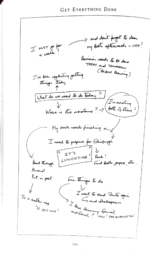Following on from yesterday’s post, where I described the fact that I had gone back to using a no-list method, I though it might be useful to describe in more detail exactly what I am using at the moment. This is one of the no-list methods which I have most often used in the past and it is a good example of the genre.
Unlike some no-list methods this only allows new tasks onto the list by doing them. You write the task down and immediately start work on it. There is no buffer.
The easiest way to explain it is by giving an example:
You decide to do email as your first task so write it down thus:
Email
You work on your email, but before you finish it decide to take a break from it and tidy your office. You cross out and re-enter Email and write Tidy as the next task:
Email
Email
Tidy
You decide to take a break from tidying, so cross it out and re-enter it.
Email
Email
Tidy
Tidy
Now here is a very important rule - Before you can enter a new task, you must take action on any active tasks before the last crossing out. In this case there is only one: Email. So you go back and work on Email. Again you don’t finish the task so you re-enter it.
Email
Email
Tidy
Tidy
Email
Now there are no active tasks before the last crossing out, so you enter a new task.
Email
Email
Tidy
Tidy
Email
Write Report
Remember that new tasks are always actioned immediately after they are entered. So you work on it for a bit and then re-enter it.
Email
Email
Tidy
Tidy
Email
Write Report
Write Report
OK, bearing in mind the rules I have given you (have another look at them if you’re not sure), what are you going to do next?
A. Work on Tidy, re-enter it if necessary, then enter and work on a new task?
B. Work on Tidy and Email, re-enter them as necessary, then enter and work on a new task?
C. Work on Tidy, Email and Write Report, re-enter them as necessary, then enter and work on a new task?
D. Keep working on Tidy, Email and Write Report and re-entering them until you have finished them, and then enter and work on a new task?
(Answer at the end of the article)
This method is far easier to action than to explain. In fact if you find it complicated to work, then you’re doing it wrong!
A couple of observations:
- Be clear how you define when a task is finished so it doesn’t hang around on the list unnecessarily.
- The number of active tasks on the list is flexible and depends on how many tasks you have re-entered. If you don’t re-enter any then the length will be one task at a time.
I’ve found the characteristics of the method to be:
- Fast
- Effective
- Flexible
- Thorough
Who could ask for anything more than that?
ANSWER TO QUESTION
The correct answer is B. Tidy and Email are active tasks before the last crossing out and so must be actioned before entering a new task. Write Report is after the last crossing-out so is not actioned at this stage.
 Friday, June 3, 2016 at 7:00
Friday, June 3, 2016 at 7:00 





